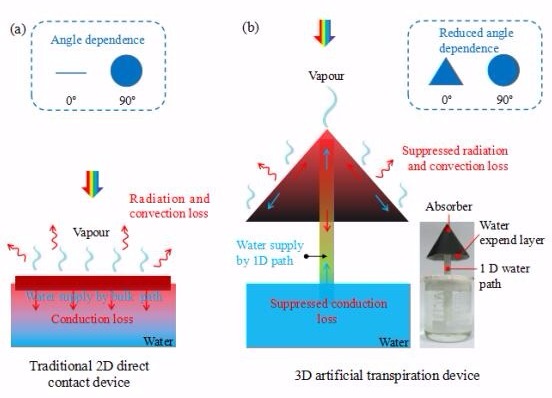Scientists develop 3D conic device to increase solar-thermal conversion


BEIJING -- Chinese scientists have developed a new device of 3D hollow-cone structure that can greatly increase the solar-thermal conversion efficiency.
The device, named artificial transpiration by Zhu Jia and his team from Nanjing University, is inspired by the transpiration processes of trees, according to an article published online recently by National Science Review, a English journal affiliated with Chinese Academy of Sciences.
It has a special 1D water path within it, which can reduce the energy loss in conduction, the article said.
The cone structure, based on graphene oxide film, can collect more sunlight throughout the day compared with a flat device, as about 10 percent to 50 percent of sunlight is diffusive. Thus it performs even better in the real world than in the laboratory, it said.
As a result, the device can enhance the solar-thermal conversion rate to 85 percent, much higher than the 40 percent of common devices, it said.
Solar power has been refrained from being applied in many sectors due to its low conversion rate caused by losses in radiation, convection and conduction. The device will open new possibilities to utilize solar energy.
Zhu's team first applied this structure to solar waste-water treatment, and the test showed that it could not only retrieve clean water but also recycle heavy metals such as copper and cadmium.
In the future, the structure can be further optimized to have a longer life time and recycle more heavy metals, the article said.
MOST POPULAR
- 1 China to give visa-free treatment to another 9 countries
- 2 China fully opens manufacturing sector to foreign investors in landmark opening up move
- 3 China's import expo attracts record-breaking participating countries, exhibitors
- 4 China's door opening even wider to foreign visitors, businesses
- 5 China revises rules to ease foreign strategic investment in listed firms
Editors' Picks
 Infographic:
China's public holidays for 2025
Infographic:
China's public holidays for 2025
 Infographic:
Basic facts of APEC
Infographic:
Basic facts of APEC
 Infographic:
Wrapping up the 7th CIIE: Data recap
Infographic:
Wrapping up the 7th CIIE: Data recap




